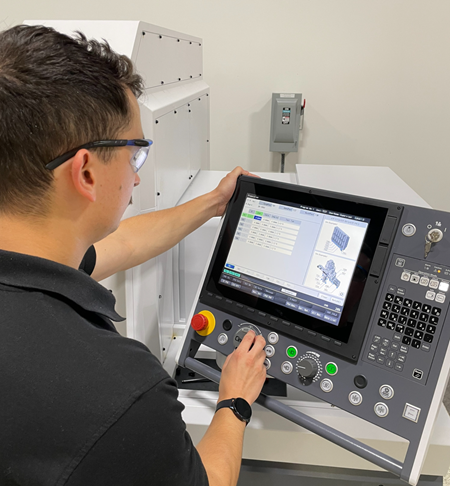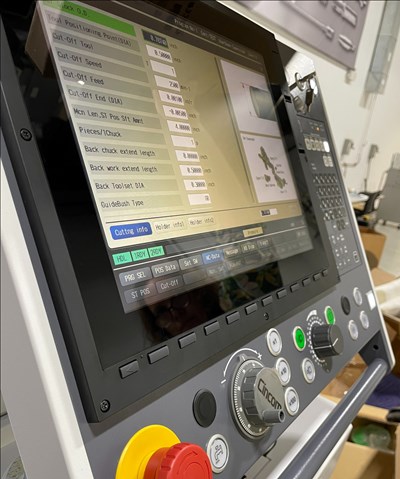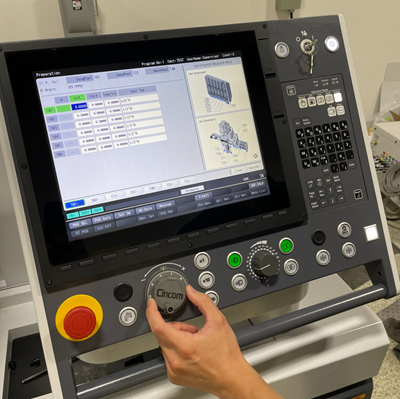Swiss-Type Control Uses CNC Data to Improve Efficiency
Sponsored ContentAdvanced controls for Swiss-type CNC lathes uses machine data to prevent tool collisions, saving setup time and scrap costs.
Share

One of the major advantages of Swiss-type lathes is how much action gets squeezed into a comparatively small work area. This enables the machine tool to dramatically increase the efficiency of part production, especially when multiple cutting tools engage the part at once.
While these tightly packed tooling configurations are designed to maximize productivity, they also create complex programming challenges for the users. Fortunately, advanced controls like those found in Swiss-type turning machines from Citizen Machinery can simplify the process and keep machines running efficiently, improving setup time and reducing scrap.
Digital Data, Tangible Results
Data-driven machining is often associated with large screens measuring spindle uptime, which users must interpret to benefit from. For Citizen CNCs, the control acts on the data by itself. For Marubeni Citizen-Cincom's Brian Such — who worked his way from the applications and support department to the position of president and COO during his 39 years at the company — the application of data is clear. “The control knows the barstock size and part length, cutoff rpm and feed rate. It knows what tool blocks are installed, the size and kind of live tools, and what position tools need to be in for safety,” he says. “Because of this, the machine knows how to make adjustments to prevent damage to the part and tooling.”
The control knows which tools are in the machine and which would require repositioning in the event of a cycle interruption.
Let’s look at the example of an unexpected cycle interruption. “Obviously, the part that was getting cut is scrapped, so you have to cut it off,” Such says. “Newer operators, or even experienced operators who forget, might not clear the cutting tools that were engaging the part before they enter the command to bring out the cutoff tool.” Hitting the wrong command in many Swiss-type turning machines can cause tool collisions and broken tools. “You can break eight tools in a second with one push of a button,” Such says. But not on a Citizen.
The Citizen control identifies which tools need moving away from the part and automatically do so before engaging other commands. “With a single button press, it moves tools out of the way, calls up the cutoff tool, closes the collet, cuts off the scrap, and then moves to the start position,” says Such. This not only dramatically reduces the likelihood of damaging tooling, but also reduces the time an operator needs to spend entering commands to clear the machine.
This feature extends to programming during setup. Rather than forcing the user to position each cutting tool, retract it and move on to the next, the machinist can move on to the next tool while the machine automatically retracts the previous one. While helpful for newer operators, even more experienced machinists can save time during setup using this feature.
“We’ve made it a practice to use technology to prevent headaches that cost our customers time and money,” Such says. For Citizen, this means using data to actively prevent damage to parts and tooling.
More Than Simulation
Citizen controls enable users to validate toolpaths with incredible accuracy thanks to its on-machine verification programs. These systems take the form of the High-Speed Program Check (HSproCk) and handwheel check, both of which occur right on the machine tool.
The HSproCk analyzes the G-code to identify syntax errors, program errors, overtravels and collision dangers without engaging any of the axes. This takes mere seconds and catches almost all major collisions. Such says the HSproCk “catches every instance when Citizen metal could touch Citizen metal.” Once this check is complete, the machinist can make all necessary changes to the G-code at the machine control.
Once this is complete, the user can perform the handwheel check to determine if any cutting tool collisions would occur. The handwheel connects to servos whose speed can be adjusted to the operator’s comfort level, and as the user turns the handwheel the machine runs through the part program. This enables the user to visually identify problems in the program that could lead to tool breakage or other problems. The user can turn the handwheel both backwards and forwards, and the screen highlights each line of G-code as its corresponding action occurs, making editing the code perfectly simple.
The control knows the exact kinematics of the machine, enabling analysis of a program in the real production environment.
Such contrasts these systems with toolpath verification software, which he says is less accurate. “The real difference is that our control has the exact kinematics of our machine,” he says. “Rather than a computer estimating what would happen if the workholding, tooling and kinematics are ideal, we have the machine analyzing itself.”
For example, toolpath verification software uses the assumed position of the tooling, while the Citizen method uses the actual positions of the tools to identify problems with the highest degree of accuracy possible. “We can identify the collisions and adjust the tool as needed, as little as 0.001 inches, to avoid it,” Such says. The accuracy of this verification system is especially useful for Swiss-type lathes, as the clusters of cutting tools quickly sliding into the part create many opportunities for collisions. “A modern Swiss program could have three tools cutting at once with seven-to-eight axes moving,” Such says. “When an operator tests it at 15% speed and those tools don’t touch, then they can trust those tools won’t touch at full speed.”
With these features, the control functions as more than a screen for operating a CAM program. It smooths over the small frustrations and time sinks that can increase costs and delay work, making it a valuable asset for both newer operators and veteran machinists.
For more information about Citizen machine tool controls, click here.

